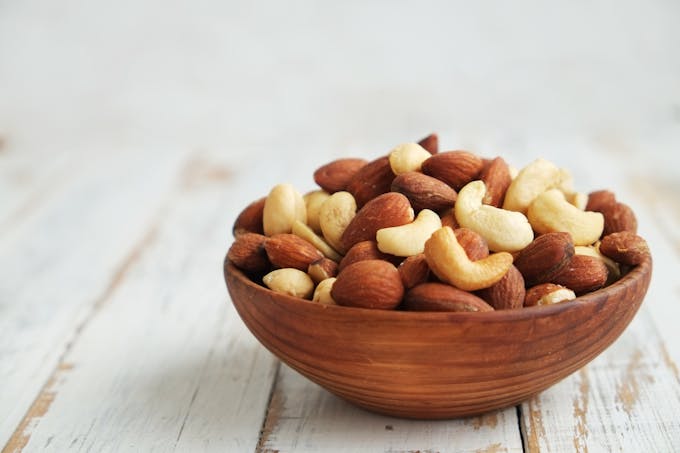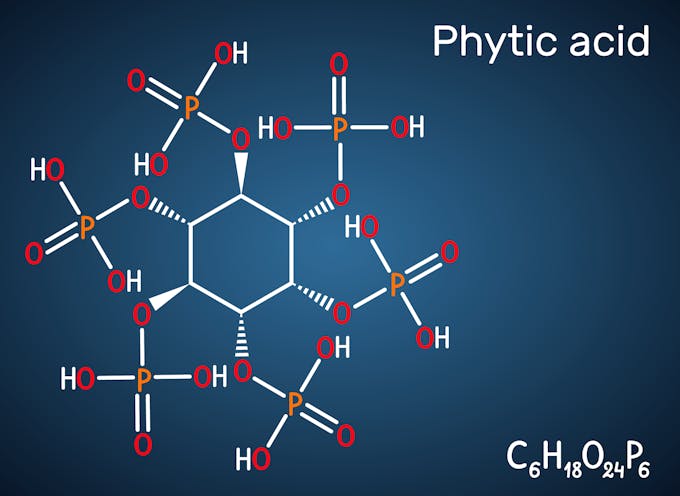Nuts Have the Highest Phytic Acid

The First Signs of a Nutrient Deficiency
Learn how to recognize early symptoms related to specific nutrient deficiencies
Receive a downloadable list of early indicators your body is lacking key nutrients

The First Signs of a Nutrient Deficiency
Learn how to recognize early symptoms related to specific nutrient deficiencies
Receive a downloadable list of early indicators your body is lacking key nutrients

The First Signs of a Nutrient Deficiency
Learn how to recognize early symptoms related to specific nutrient deficiencies
Receive a downloadable list of early indicators your body is lacking key nutrients

The First Signs of a Nutrient Deficiency
Learn how to recognize early symptoms related to specific nutrient deficiencies
Receive a downloadable list of early indicators your body is lacking key nutrients

The First Signs of a Nutrient Deficiency
Learn how to recognize early symptoms related to specific nutrient deficiencies
Receive a downloadable list of early indicators your body is lacking key nutrients

The First Signs of a Nutrient Deficiency
Learn how to recognize early symptoms related to specific nutrient deficiencies
Receive a downloadable list of early indicators your body is lacking key nutrients

The First Signs of a Nutrient Deficiency
Learn how to recognize early symptoms related to specific nutrient deficiencies
Receive a downloadable list of early indicators your body is lacking key nutrients

The First Signs of a Nutrient Deficiency
Learn how to recognize early symptoms related to specific nutrient deficiencies
Receive a downloadable list of early indicators your body is lacking key nutrients

The First Signs of a Nutrient Deficiency
Learn how to recognize early symptoms related to specific nutrient deficiencies
Receive a downloadable list of early indicators your body is lacking key nutrients

The First Signs of a Nutrient Deficiency
Learn how to recognize early symptoms related to specific nutrient deficiencies
Receive a downloadable list of early indicators your body is lacking key nutrients

The First Signs of a Nutrient Deficiency
Learn how to recognize early symptoms related to specific nutrient deficiencies
Receive a downloadable list of early indicators your body is lacking key nutrients

The First Signs of a Nutrient Deficiency
Learn how to recognize early symptoms related to specific nutrient deficiencies
Receive a downloadable list of early indicators your body is lacking key nutrients

The First Signs of a Nutrient Deficiency
Learn how to recognize early symptoms related to specific nutrient deficiencies
Receive a downloadable list of early indicators your body is lacking key nutrients

The First Signs of a Nutrient Deficiency
Learn how to recognize early symptoms related to specific nutrient deficiencies
Receive a downloadable list of early indicators your body is lacking key nutrients

The First Signs of a Nutrient Deficiency
Learn how to recognize early symptoms related to specific nutrient deficiencies
Receive a downloadable list of early indicators your body is lacking key nutrients

The First Signs of a Nutrient Deficiency
Learn how to recognize early symptoms related to specific nutrient deficiencies
Receive a downloadable list of early indicators your body is lacking key nutrients

The First Signs of a Nutrient Deficiency
Learn how to recognize early symptoms related to specific nutrient deficiencies
Receive a downloadable list of early indicators your body is lacking key nutrients
Phytic acid is a naturally occurring chemical found in nuts, seeds, and whole-grain cereals. It’s a fascinating substance that delivers profound health benefits and, at the same time, can cause nutrient deficiencies.
Let’s take a detailed look at phytic acid, its role in health and mineral absorption, and what you can do to get the maximum nutritional benefit from eating nuts.

What is phytic acid?
Phytic acid, or phytate, is found in most edible seeds like nuts, whole grains, and legumes. Its primary roles are to protect the seed from damage and to store large amounts of phosphorus.
Once the seed germinates, phytic acid releases phosphorus which acts as a natural fertilizer, helping the seed to grow into a young plant.
It’s not uncommon to find phytic acid added to commercial food products. It’s a potent antioxidant and preservative that extends the shelf life of foods.
Watch the video below to learn more about phytic acid in nuts.
Phytic acid side effects
Dietary phytates can cause digestive issues and impair the absorption of nutrients in the digestive tract, reducing the mineral bioavailability of foods.
Some potential adverse effects of phytic acid are:
Mineral deficiencies
Because of its chemical structure, phytic acid is considered an anti-nutrient. It binds easily to certain minerals, and consuming anti-nutrients like phytate regularly may result in mineral deficiencies.
Here are four mineral deficiencies that can be caused by phytic acid:
1. Iron deficiency
Foods high in phytic acids inhibit iron absorption, increasing your risk of iron deficiency and anemia. Particularly the absorption of iron from plant foods, also called nonheme iron, is significantly reduced by phytic acid.
Iron in animal protein is called heme iron, which is less affected by phytic acid, placing vegans and vegetarians at increased risk of low iron stores.
Iron deficiency can cause anemia, lack of energy, heart palpitations, and low exercise tolerance.
2. Zinc deficiency
Consuming too much phytic acid can lower your body's ability to absorb zinc, resulting in an increased risk of zinc deficiency.
Symptoms like poor wound healing, acne, arthritis, and sensitivity to cold can indicate low zinc stores.
3. Calcium deficiency
Eating calcium-rich foods in combination with foods high in phytic acid can lead to significantly reduced absorption of calcium.
Calcium deficiency increases your risk of osteoporosis, poor dental health, muscle cramps, and insomnia.
4. Copper deficiency
Copper deficiency is another potential side effect of phytic acid. Copper is necessary for blood sugar control, and copper deficiency can worsen insulin resistance, anemia, and muscle weakness.
Bloating and abdominal discomfort
Phytic acid can inhibit digestive enzymes, resulting in sluggish digestion, bloating, and abdominal pain after eating phytate-rich foods like nuts.
If phytic acid causes symptoms somewhat depends on your digestive health, enzyme levels, and overall diet, explaining why some people react to phytate-rich foods while others don't.

Phytic acid benefits
Despite being classified as an anti-nutrient, phytic acid has positive health effects and can safely be a part of a balanced diet.
The same chemical structure responsible for blocking nutrient absorption also has potent antioxidant properties associated with health benefits like:
Reduced risk of colon cancer
Research found that dietary phytate can lower the risk of colon cancer. Although not fully understood how, it’s believed that phytate protects colon cells from oxidation responsible for DNA damage and cancer development.
Improved blood sugar control
Phytic acid is believed to support pancreatic function and balanced insulin production, lowering the risk of insulin resistance and type 2 diabetes.
Reduced mineral overload
Because of its affinity to bind with minerals, phytic acid can support healthy nutrient levels by binding to excessive amounts of minerals in the body.
Some people are prone to accumulate excessive levels of iron and zinc, which is associated with an increased risk of damage to DNA and chronic disease.
Phytates are believed to prevent excessive iron levels and protect the body from the harmful effects of mineral overload.
Phytic acid prevents calcium crystallization which can lower the risk of kidney stones.
Supports digestive health
Beneficial bacteria in your gut produce microbial phytase, an enzyme that breaks down phytic acid. The more phytate-rich foods you eat, the more microbial phytate your microbiome will produce.
This study indicates that phytase enzymes benefit your gut health and are a probiotic that helps the beneficial bacteria in your colon to thrive.
Supports bone health
Phytate’s ability to bind to calcium can benefit bone health. It reduces the risk of osteoporosis by preventing the breakdown of calcified minerals in your bones.

High phytic acid nuts
Nuts have a considerably higher phytic acid content than other plant foods, and some nuts contain more phytic acid than others.
The nuts with the highest amount of phytic acid are:
Almonds - 9.4% phytic acid
Walnuts - 6.7% phytic acid
Brazil nuts - 6.3% phytic acid
How to reduce phytic acid in nuts
You can take steps to remove phytates from certain foods like nuts and reduce the risk of phytate-related mineral deficiencies and gastrointestinal symptoms.
Phytic acid levels are significantly reduced by soaking. Soaking triggers the germination process, which releases the enzyme phytase and causes the breakdown of phytic acid.
Germinating makes nuts more digestible and removes phytic acid. You can soak nuts overnight in fresh water and dehydrate them at low temperatures in the oven or use a dehydrator. Watch this video to learn more about how to germinate seeds and nuts.
To further reduce the risk of mineral deficiency, combine foods rich in iron with vitamin C-rich foods like bell pepper or Brussels sprouts. Vitamin C naturally counteracts phytic acid by increasing intestinal iron absorption.

Key takeaways
Most nuts contain phytic acid, a complex natural substance with health benefits but may also increase your risk of mineral deficiencies.
Not all nuts are created equal, some nuts are better for keto than others. The fat-to-carb ratio is the most important factor in choosing keto-friendly nuts. Nuts like pecans, walnuts, brazil nuts, macadamia nuts, and almonds are best for a keto diet.
Consuming germinated nuts as part of a nutrient-dense diet is unlikely to cause any negative health effects. Soaking lowers levels of phytates and makes nuts easier to digest.
To reduce the risk of mineral deficiencies caused by phytate, combine vitamin C-rich foods with meat and plant foods to boost iron absorption and reduce the risk of mineral deficiencies.
FAQs
1. Is phytic acid bad?
Phytic acid is a natural chemical with several health benefits but may increase your risk of mineral deficiencies.
Phytic acid is classified as an anti-nutrient and can contribute to nutrient deficiencies by inhibiting zinc, copper, calcium, and nonheme iron absorption. However, it’s also a powerful antioxidant that protects DNA and amino acids from oxidation lower the risk of colon cancer, improves insulin signaling, and has probiotic effects for beneficial bacteria in your gut.
2. How much phytic acid is in nuts?
Most nuts contain phytic acid. Almonds, walnuts, and Brazil nuts have the highest amounts of phytic acid.
Almonds contain 9.4% phytic acid, walnuts contain 6.7% phytic acid, and Brazil nuts contain 6.3% phytic acid.
3. Can I soak nuts to reduce phytic acid?
Yes, soaking is an excellent technique to remove phytic acid from nuts. Soaking releases the enzyme phytase responsible for breaking down phytic acid.
4. Does phytic acid cause bloating?
Yes, phytic acid can cause bloating and other unpleasant digestive issues. Phytic acid can inhibit digestive enzymes in your small intestines resulting in impaired digestion.
If food isn't properly digested, fats, proteins and starches remain in your intestines and are fermented by the bacteria in your gut. Gas is a by-product of bacterial fermentation, explaining why phytic acid can cause bloating.
5. Can phytic acid slow digestion?
Yes, phytic acid can slow your digestion. Digestive enzymes in your small intestines can be inhibited by phytic acid, leading to slower digestion and poorly absorbed fats, proteins, and starches.
6. How much phytic acid can I have?
The amount of phytic acid you can have without adverse effects depends on factors like your overall diet and digestive enzyme levels. Eating some phytate-containing foods as part of a balanced and nutrient-dense diet rarely causes mineral deficiency or digestive issues.
Some people are more sensitive to phytic acid than others. Pay attention to your body and tweak your diet if you experience any symptoms after eating nuts.
7. How can I reduce phytic acid in nuts?
You can soak nuts to lower the phytic acid content. Soaking starts the germination process, which causes the enzyme phytase to be released. Because phytase breaks down phytic acid, soaking is an excellent way to minimize digestive side effects and reduce the risk of mineral deficiencies.
8. Is phytic acid really a health concern?
Consuming some phytic acid-containing foods as part of a nutrient-dense, balanced diet typically doesn't cause any health concerns. Iron or zinc deficiency isn't a concern if you consume meat regularly. Soaking nuts will minimize phytic acid side effects.
Phytic acid can be a health concern in some developing countries that primarily rely on phytate-rich food sources like cereals, wheat bran, and grains. Because phytate lowers the bioavailability of minerals, mineral deficiencies are a much more prominent health concern in low-income countries.
Previous blog
The Amazing Benefits of SugarTags

Popular
08/21/2024
41.2K views
05/22/2024
37.4K views
11/18/2024
218.1K views
03/18/2024
11/21/2022




